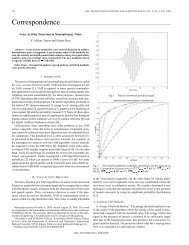Thesis (PDF) - Signal & Image Processing Lab
Thesis (PDF) - Signal & Image Processing Lab
Thesis (PDF) - Signal & Image Processing Lab
Create successful ePaper yourself
Turn your PDF publications into a flip-book with our unique Google optimized e-Paper software.
32 CHAPTER 2. THEORETICAL BACKGROUND<br />
Keshet also defines in [16] the notion of boundary topographic distance (BTD)<br />
of a pixel x of a bounded image f, as the topographic distance between x and the<br />
boundary of f. That is, the BTD of x is the least topographic distance between x<br />
and any point on the boundary of f. The BTD function, BTf, is the mapping from<br />
each pixel x to its BTD, BTf(x).<br />
2.5.2 An extension of boundary topographic distance defini-<br />
tion<br />
The notion of BTD, defined by Keshet, can be easily extended, allowing the boundary<br />
of the image f to be any connected flat zone of f. The notion of flat zone is discussed<br />
in section 2.2. In some cases, a boundary of an image isn’t the best starting point<br />
for topographic distance calculation, because it is arbitrary set by the properties and<br />
position of the camera used to take the picture. When choosing another flat zone,<br />
as a reference for the topographic distance, the choice can be more meaningful and<br />
suited for the problem to be solved.<br />
For instance, in some applications it can be useful to define the boundary as the<br />
largest flat zone of the image. Another example is shown in Fig. 2.9. In this example<br />
a root flat zone is chosen to a be a symmetric center of the image - the circle center.<br />
2.5.3 Boundary Topographic Variation (BTV) Transform<br />
Let πf(x) be a connected path linking the boundary of an image f to a pixel x and<br />
ˆπf(x) be one such path, with least topographic distance between x and the boundary.<br />
The topographic distance (total variation) on ˆπf(x) is exactly BTf(x) and ˆπf(x) is<br />
called a minimal-BTD path for x. There may be more than one minimal-BTD path<br />
for a given point x.<br />
Assume that a minimal-BTD path is associated with an alternating sequence (AS).<br />
The AS describes the “ups and downs” that occur on that path. These “ups and<br />
downs” are called path variation. For instance, consider a grayscale image f, and<br />
suppose that a minimal-BTD path ˆπf(x) from the boundary to a pixel x has the<br />
following function values:<br />
f(ˆπf(x)) = (0, 2, 6, 9, 8, 8, 5, 1, 3, 7, 7, 4, 5). (2.19)
















